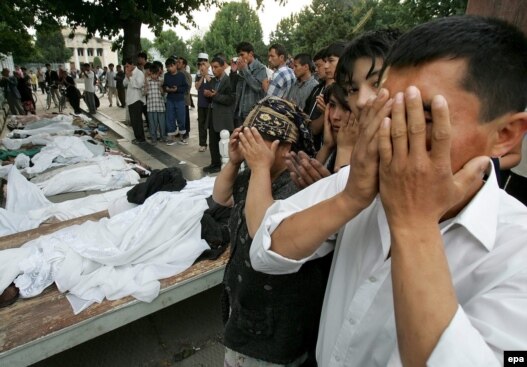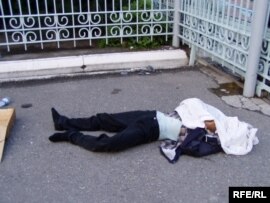Features
Five Years After Andijon Events, Key Questions Remain Unanswered
What is now widely known as the “Andijon massacre” transpired when government forces opened fire on crowds of protesters who had been staging peaceful antigovernment demonstrations in the city for several days.
To this day, little is known about what ignited the violence, or even how many victims there were. RFE/RL looks at some of the key questions that remain unanswered.
What prompted the demonstrations?
Injustice, religion, poverty, and harsh state repression were all part of the volatile mix brewing in the days leading up to the bloodshed of May 13, 2005.
Of these, growing discontent over the economic situation in eastern Uzbekistan is most often cited as the basis for the demonstrations, with the arrest of 23 local business leaders upon which many Andijon residents depended seen as the catalyst. Demonstrators demanded the release of the businessmen, who were being tried for their alleged extremist and separatist activities related to their involvement with “Akramiya,” an organization banned by the government as an Islamic group.
Other theories have also been floated as reasons for the demonstrations, including that they were part of a power struggle between Uzbekistan’s political clans, or evidence of a fledgling “colored revolution” akin to that seen in Kyrgyzstan just weeks before.
What Is Akramiya?
The Uzbek authorities claim Akramiya was an Islamist organization bent on replacing the government in Tashkent with an Islamic state, but things aren’t nearly so cut and dry. The group has also been described as a close-knit business community that collected membership fees, provided discounted goods to members, and was actively involved in local charitable activities.
Members of the Akramiya community have told RFE/RL that they had good relations with the local authorities, even claiming that they had bribed officials as a way to gain favor. It is unclear what might have happened to sour those good relations.
Reports widely cite Akramiya as having been founded in 1992 by then-29-year-old Andijoni math teacher Akram Yuldoshev. In the late 1990s, Akramiya became a household name after the Uzbek authorities banned the organization. Yuldoshev himself was imprisoned in 1999, and continues to serve a 17-year prison term.
Akramiya’s alleged involvement in the Andijon uprising is disputed by human rights activists, Uzbek opposition figures in exile, independent media, and at least one former Uzbek security agent. Russian media have speculated that the group never existed at all, and was made up by the Uzbek government to justify a crackdown on religious extremism.
Who freed the prisoners?
The Uzbek authorities arrested the 23 Andijoni businessmen on the basis of their separatist and Islamist aims in relation to their membership in Akramiya. This, in turn, is alleged to have caused outrage among their sympathizers.
The official line is that on the night of May 12, a group of men attacked a military garrison, seized arms, then set upon the Andijon city jail and freed prisoners, including the local businessmen. Several prison guards were reportedly killed in the violence, and a few official buildings were taken over by the armed men.
This violence was cited by the government as the reason for the harsh crackdown that ensued. But up until May 12 the protests in Andijon had largely been described as peaceful, and participants as unarmed civilians. With no one coming forward to take responsibility for the action, the suggestion has been made that the group was not connected to the protests at all. It remains unclear who, exactly, the gunmen were.
How many people died on May 13, 2005?
In the early evening of May 13, government troops fired into crowds of protesters, which included women and children, in what is today known as the “Andijon massacre.”
The precise number of people who died that day, however, is hotly disputed. The number given by Uzbek officials is 187, including government troops. The breakdown: 94 terrorists, 20 law enforcement officials, 11 soldiers, 57 ordinary residents, and five unidentified individuals. The estimated number of dead given by rights groups and government opponents, however, ranges from several hundred to nearly 1,000.
The Shanghai Cooperation Organization, a regional security grouping of which Uzbekistan is a member, backed Tashkent’s official version of events, saying it was a plot by terrorists and extremist groups. An EU fact-finding delegation sent to the city in 2006, more than a year after the bloodshed, was unable to gather more information. A Europe-based group called “Andijon — Justice and Resurrection” continues to pursue the issue, and claims to have gathered testimony identifying and verifying the deaths of an additional 68 protesters.
What happened to the injured?
Both sides agree that many people were killed on May 13, 2005, but with no official casualty figures issued, the number of those injured remains one of the biggest mysteries of Andijon. According to eyewitness reports and right groups, government forces shot injured protesters lying in the streets, presumably to finish off the wounded.
In a hearing in Brussels in early May 2010, a former medical employee of an Andijon morgue claimed government forces brought at least one injured man there. The man, speaking on condition of anonymity in a video, said that the man was very much alive when he got there, according to an RFE/RL Uzbek Service correspondent who attended the hearings. However, the man testified, after leaving the room for a few moments he returned to find that the policeman had shot and killed him.
Where are the bodies?
Eyewitnesses of the Andijon events, including an RFE/RL Uzbek Service correspondent, refugees, and rights activists say the bodies of protesters — mostly women and children — were loaded onto trucks and trailers, driven out of Andijon, and buried in mass graves in unknown locations.
After some Andijon inhabitants claimed there were mass graves on the city’s outskirts, an RFE/RL correspondent visited one such site on May 27, 2005, and was shown what appeared to be 37 gravesites. Claims of the existence of mass graves have never been verified or officially addressed by the government. Foreign media and rights activists have noted that while the bodies of dead men were returned to their relatives, the bodies of women and children believed killed in the Andijon unrest have never been accounted for.
What became of Akramiya?
After Uzbek government forces moved in to take control of Andijon, hundreds of the city’s residents fled across the border to nearby Kyrgyzstan. From there, some 400 Andijon refugees eventually moved on to settle in Europe, North America, and Australia.
After one year, reports began to emerge that some refugees had begun to return to Uzbekistan, where they faced the prospect of arrest. RFE/RL’s Uzbek Service reported in April that Diloram Abduqodirova, a housewife with four children who emigrated to Australia but was arrested at Tashkent airport upon returning to Uzbekistan in January, was sentenced to 10 years and two months in prison for her role in the Andijon protests.
Of the 23 Akramiya businessmen, three currently reside in Holland, one in Finland, one in Sweden, and one in the United States. One of the businessmen is missing and his fate is unknown. The remaining 16 were jailed in Uzbekistan, of which one, Ortiqov Muhammadshokir, died under unclear circumstances.
In the immediate aftermath of the Andijon events, Uzbekistan demanded that the Kyrgyz authorities extradite those Akramiya businessmen who had sought refuge there. They were never handed over, possibly in part due to warnings by rights groups that they could face torture and even the death penalty in Uzbekistan.
compiled by Farangis Najibullah, with contributions from RFE/RL’s Uzbek Service




Sorry, the comment form is closed at this time.